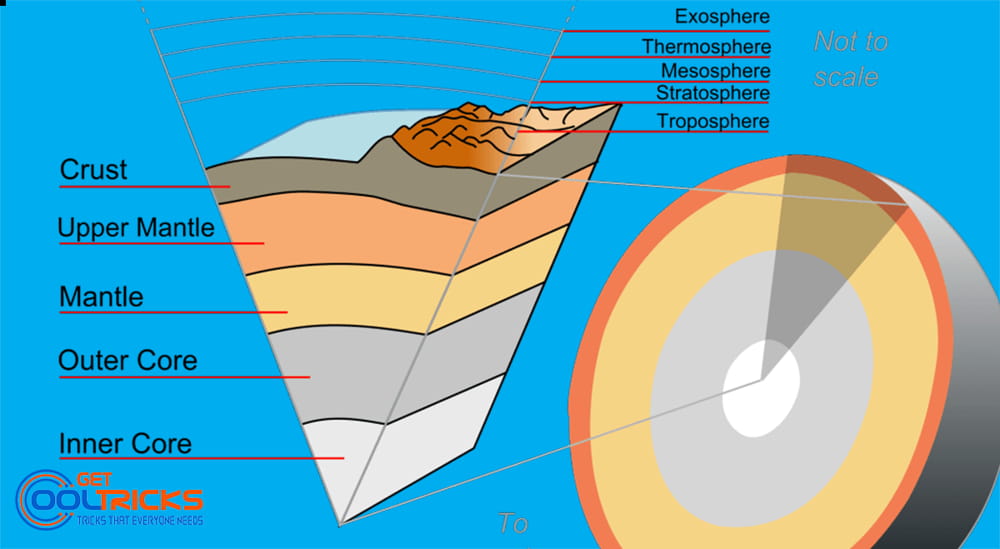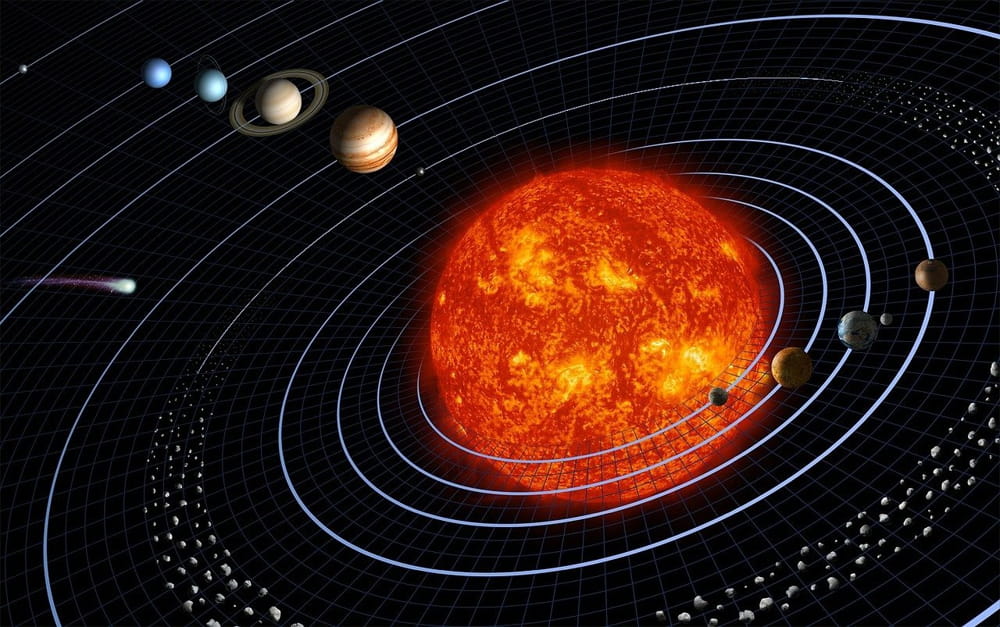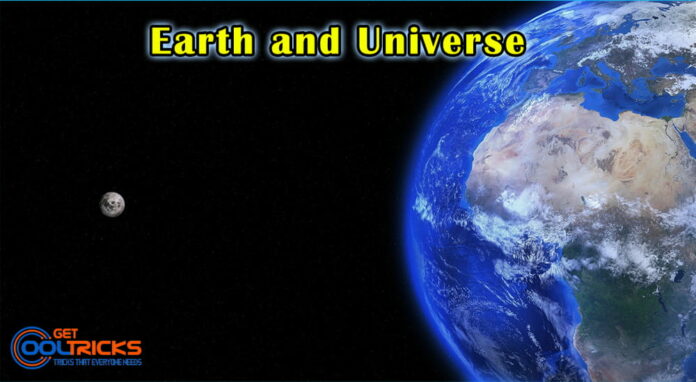Earth
Earth’s gravity interacts with other objects in space, especially the Sun and the Moon, Earth’s only natural satellite. Earth revolves around the Sun in 365.26 days, a period known as an Earth year. During this time, Earth rotates about its axis about 366.26 times.
Layers of Earth

1. Crust
- The solid crust is the outermost and thinnest layer of our planet. The crust averages 25 miles (40 kilometres) in thickness and is divided into fifteen major tectonic plates that are rigid in the centre and have geologic activity at the boundaries, such as earthquakes and volcanism.
- The most abundant elements in the Earth’s crust include (listed here by weight %) oxygen, silicon, aluminium, iron, and calcium. These elements combine to form the most abundant minerals in the Earth’s crust, members of the silicate family – plagioclase and alkali feldspars, quartz, pyroxenes, amphiboles, micas, and clay minerals.
2. Mantle
- Mantle material is hot (932 to 1,652 degrees Fahrenheit, 500 to 900 degrees Celsius) and dense and moves as a semi-solid rock. The mantle is 1,802 miles (2,900 km) thick and is composed of silicate minerals that are similar to ones found in the crust, except with more magnesium and iron and less silicon and aluminium.
- The base of the mantle, at the boundary with the outer core, is termed the Gutenberg discontinuity. It is at this depth (1,802 miles, 2,900 km) where secondary earthquake waves, or S waves, disappear, as S waves cannot travel through liquid.
- Scientists are utilizing seismic tomography to construct 3-dimensional images of the mantle, but there are still limitations with the technology to fully map the Earth’s interior.
3. Outer Core
- The outer core is composed mostly of iron and nickel, with these metals found in liquid form.
- The outer core reaches between 7,200 and 9,000 degrees Fahrenheit (4,000 and 5,000 degrees Celsius) and is estimated to be 1,430 miles (2,300 km) thick.
- It is the movement of the liquid within the outer core that generates Earth’s magnetic field.
4. Inner Core
- The inner core is the hottest part of our planet, at temperatures between 9,000 and 13,000 degrees Fahrenheit (5,000 and 7,000 degrees Celsius).
- This solid layer is smaller than our Moon at 750 miles (1,200 km) thick and is composed mostly of iron.
- The iron is under so much pressure from the overlying planet that it cannot melt and stays in a solid state.
- The inner core is the hottest part of our planet, at temperatures between 9,000 and 13,000 degrees Fahrenheit (5,000 and 7,000 degrees Celsius). This solid layer is smaller than our Moon at 750 miles (1,200 km) thick and is composed mostly of iron. The iron is under so much pressure from the overlying planet that it cannot melt and stays in a solid state.
Universe
- The Universe is all of space and time and their contents, including planets, stars, galaxies, and all other forms of matter and energy. While the spatial size of the entire Universe is still unknown, it is possible to measure the observable universe.
- Further observational improvements led to the realization that our Sun is one of hundreds of billions of stars in a galaxy we call the Milky Way, which is one of hundreds of billions (perhaps trillions) of galaxies in the Universe.
- Many of these stars have planets.
- At the largest scale galaxies are distributed uniformly and the same in all directions, meaning that the Universe has neither an edge nor a centre.
- From studying the movement of galaxies, we know that the universe contains much more matter than we can detect in usual ways.
Milky Way Galaxy
- The Milky Way is the galaxy that contains our Solar System.
- The descriptive “milky” is derived from the appearance from Earth of the galaxy – a band of light seen in the night sky formed from stars that cannot be individually distinguished by the naked eye.
- Galileo Galilei first resolved the band of light into individual stars with his telescope in 1610. Until the early 1920s, most astronomers thought that the Milky Way contained all the stars in the Universe.
- The Milky Way has several satellite galaxies and is part of the Local Group of galaxies, which form part of the Virgo Supercluster, which is itself a component of the Laniakea Supercluster.
- The constant rotation speed contradicts the laws of Keplerian dynamics and absorbs electromagnetic radiation. This mass has been termed “dark matter”.
The Solar System

- We can see the Sun, Moon, and the five planets mentioned before with the Naked Eyes.
- The Sun has Eight Planets, All Planets revolve around the sun.
- The eight planets have been classified into Solid Planet and Gaseous Planets. Mercury, Venue, Earth and Mars are called as Solid Planets. While Jupiter, Saturn Uranus and Neptune are gaseous Planets.
Dwarf Planets
Pluto, Charon, Ceres, and Eris were newly grouped as “Dwarf Planets” in the year 2008. They also revolve around the sun. They also revolve around the sun. They are very small in size. Their Size is smaller than our Moon. So they are called DWARF PLANETS.
Asteroids
Thousands of Asteroids are found between Mars and Jupiter. Asteroids are Clusters of Celestial Bodies which Includes tiny Stones and big rocks which can measure up to 300 to 400 km in diameter.
Meteroids
The Sudden Streaks of light seen on a starry night are called as METEOROIDS. This can be seen when the remains of the rocky parts of the comets strike the Earth’s atmosphere and streaks of light are generated. They are not stars that fall down.
Comet
- It is exciting to see a comet in the Night Sky. A Comet is not a star. It is a Rock made of Dust and Ice. The long tail is seen because, as the comet comes near the sun, the ice melts and reflects the light of the sun.
- The tail of the comet is seen in the opposite direction of the sun. The tail of the comet appears because minute particles from the sun strike the gaseous part emitted from the comet.
Black Hole
- Black holes are not physically large regions of space. But when you include their mass, they are among the top competitors for the largest things in the universe. And quasar OJ287 is the largest black hole we’ve spotted.
- It’s estimated to be 18 billion times the mass of our sun and is a supermassive black hole located in the centre of a galaxy. To put that in perspective, it’s an object larger than our entire solar system. Just how big can a black hole get? According to scientists, there is no theoretical upper limit.
Moon
- The Moon is called by different names in Tamil. The moon is not a Planet.
- Moon does not revolve around the sun directly. It revolves around the Earth. Hence it is called as a Satellite.
- The Moon is the Satellite of the earth.
Dark Matter
- Dark matter is a hypothetical kind of matter that is invisible to the entire electromagnetic spectrum, but which accounts for most of the matter in the Universe.
- The existence and properties of dark matter are inferred from its gravitational effects on visible matter, radiation, and the large-scale structure of the Universe.
- Other than neutrinos, a form of hot dark matter, dark matter has not been detected directly, making it one of the greatest mysteries in modern astrophysics.
- Dark matter neither emits nor absorbs light or any other electromagnetic radiation at any significant level.
- Dark matter is estimated to constitute 26.8% of the total mass-energy and 84.5% of the total matter in the Universe.
Dark Energy
- Two proposed forms for dark energy are the cosmological constant, a constant energy density filling space homogeneously, and scalar fields such as quintessence or moduli, dynamic quantities whose energy density can vary in time and space.
- Contributions from scalar fields that are constant in space are usually also included in the cosmological constant. The cosmological constant can be formulated to be equivalent to vacuum energy. Scalar fields having only a slight amount of spatial inhomogeneity would be difficult to distinguish from a cosmological constant.


